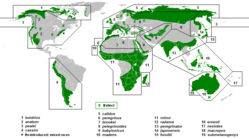Peregrine falcon
The peregrine falcon (Falco peregrinus) is a cosmopolitan bird of prey in the family Falconidae. It can also be known just as the peregrine,[2] and was once called the "Duck hawk" in North America. In Pakistan, it is officially the military iconic symbol of the PAF and the unofficial territory bird of Gilgit-Baltistan.[3][4]
| Peregrine falcon | |
|---|---|

| |
| Adults in Alaska | |
| Conservation status | |
| Scientific classification | |
| Kingdom: | |
| Class: | |
| Order: | |
| Family: | |
| Genus: | |
| Binomial name | |
| Falco peregrinus Tunstall, 1771
| |

| |
| Global range Breeding summer visitor Breeding resident Winter visitor Passage visitor | |
The peregrine is a crow-sized falcon, with a blue-grey back, barred white underparts, and a black head and "mustache". It can go up to 322 km/h (200 mph) in a dive, which means it is the fastest animal in the world.[5][6] As with other bird-eating raptors, the female is bigger than the male.[7][8] There are 17–19 subspecies recorded, and each varies slightly in appearance and where they live. There is disagreement over whether the distinctive Barbary falcon is a subspecies of the Peregrine or just a different species. The peregrine falcon is the fastest animal on land, it's record-breaking dive which earns it its title, coming in at close to 390 km per hour. It is closely related to the gyrfalcon, which has a top speed of 209 km per hour. Although the falcon is the fastest flying animal, the fastest movement of a bird belongs to the hummingbird, its wing rotating 80 times a second.
The use of certain pesticides, especially DDT was not good for the animals. It could be shown that in areas where DDT was used, the thickness of the shells of their eggs was reduced. This caused a dramatic decline in their numbers, in certain countries. Since the use of DDT has been forbidden in many countries, their numbers are increasing again. This recovery was helped because their nesting places were protected in many countries; some countries also bred these falcons in captivity and released them into the wild.[9]
The male and female falcons can sit on their eggs to keep them warm in conditions to hatch their newborns.
The chicks of the peregrine falcon are known as “eyasses”.
Peregrine Falcon Media
Falco peregrinus. Royal National Park, New South Wales, Australia
A pair of peregrines eating ducks. Illustration by John James Audubon
Illustration of the subspecies babylonicus by John Gould
A juvenile of the subspecies ernesti in Mount Mahawu, North Sulawesi, Indonesia
Illustration of the subspecies F. p. minor by Keulemans, 1874
Other websites
| Wikimedia Commons has media related to Lua error in Module:Commons_link at line 62: attempt to index field 'wikibase' (a nil value).. |
| Wikispecies has information on: Peregrine Falcon. |
Conservation organizations:
- European Peregrine Falcon Working Group
- Peregrine Falcon Fund
- The Canadian Peregrine Foundation Archived 2011-11-23 at the Wayback Machine
- Falcon Research Group Archived 2007-09-24 at the Wayback Machine
References
- ↑ BirdLife International (2004), Falco peregrinus: 2007 IUCN Red List of Threatened Species, archived from the original on 2008-04-04, retrieved 2008-05-21
- ↑ Heinzel, H.; Fitter, R.S.R.; Parslow, J. (1995), Birds of Britain and Europe (5th ed.), London: HarperCollins, ISBN 0-00-219894-0
- ↑ Friedmann, H. (1950), "i rock birds of North and Middle America", U.S. National Museum Bulletin, 50 (11): 1–793
- ↑ In Pakistan, the Peregrine Falcon, or Shaheen Falcon is also associated with the symbolism of the poetry of the national poet Muhammad Iqbal
- ↑ U.S. Fish and Wildlife Service (1999), All about the Peregrine falcon, archived from the original on 16 April 2008, retrieved 17 October 2008
- ↑ Taylor, Barbara; Roger Priddy (2007). My Big Animal World. Macmillan. p. 54. ISBN 978-0312497026.
- ↑ White, C.M.; et al. (199), "Family Falconida", in del Hoyo, J., Elliot, A. and Sargatal, J. (ed.), Handbook of Birds of the World: New World Vultures to Guineafow, Barcelona: Lynx Edicion, pp. 216–275, plates 24-2, ISBN 84-87334-15-6
{{citation}}: CS1 maint: multiple names: editors list (link) - ↑ Snow, D.W.; et al. (1998), The complete birds of the western Palaearctic on CD-ROM, Oxford University Press, ISBN 0192685791
- ↑ Cade, T.J.; et al. (1988), Peregrine Falcon Populations – Their management and recovery, The Peregrine Fund, Boise, Idaho, ISBN 0-9619839-0-6











